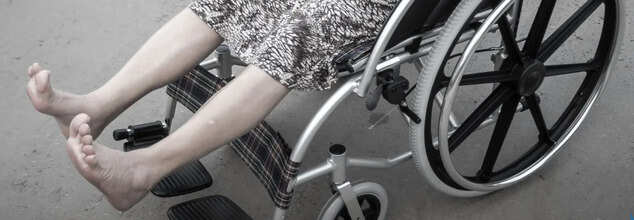- Health Conditions A-Z
- Health & Wellness
- Nutrition
- Fitness
- Health News
- Ayurveda
- Videos
- Medicine A-Z
- Parenting
- Web Stories

(Credit-Canva)
Signs That Reveal You May Be Missing THIS Essential Nutrient Your Body
Going about your day-to-day life can often be hectic. You may try to cram everything you need into a day through meals, activities etc., but that is not possible. Even if you eat healthy foods, it is possible that you experience some deficiency. Often these deficiencies have misleading symptoms or signs that may lead you to think it is nothing serious. That is why it is important to make sure you are eating wholesome and well-rounded meals, as well as getting checked regularly.
Not having enough adequate essential nutrients can cause significant changes to your body. One such nutrient is Iodine. Dr. Eric Berg, popularly known as Dr. Berg on social media, who is a board-certified chiropractor based in xxx, is a well-known YouTube personality who shared his knowledge about Iodine and its deficiencies. He explained that if we don't have sufficient iodine, our bodies cannot produce enough of these vital thyroid hormones, and that can lead to various health issues and affect how our bodies function daily. Therefore, even though it's a trace element, obtaining adequate iodine is actually crucial for maintaining good health.
Signs of Low Iodine
Dr Berg explained that iodine is truly vital for the thyroid gland. This small gland in our neck performs a significant role because it influences nearly every single system within our body. Here are some strange signs of it you may be experiencing:
Outer Eyebrow Thinning
If you notice the hair on the outer edges of your eyebrows starting to get thinner or even disappear, this could be a subtle sign that your body isn't getting enough iodine, which is important for healthy hair growth.
Increased Hair Loss
Losing more hair from your head than usual, like finding extra strands on your pillow or in the shower drain, might be a signal that your iodine levels are low, as iodine helps keep hair follicles healthy and strong.
Hoarseness
If your voice starts to sound rough or hoarse for no clear reason, like a cold, it could be related to your thyroid not working properly due to low iodine, which can affect the vocal cords.
Enlarged Tongue with Indentations
If your tongue looks bigger than it used to, and you can see little dents or scalloped edges along the sides, this unusual change might be a sign that you're not getting enough iodine.
Unexplained Weight Gain
Putting on weight even though you haven't changed how much you're eating could be a sign of low iodine, as the thyroid needs iodine to help control how your body burns energy.
Symptoms Linked to Elevated Estrogen
For women, things like gaining weight around the hips and having periods that are much heavier or more painful than normal might be connected to low iodine and its effect on hormone balance.
Impaired Cognitive Function
If you're finding it harder to remember things, focus on tasks, or solve problems, it could be a sign that your iodine levels are low, as iodine is important for healthy brain function at all ages.
Can Food Improve Iodine Deficiency?
The good news is that most people can easily get enough iodine by just eating a mix of different foods. Lots of common things we eat have iodine in them. For example, milk and other dairy foods like cheese and yogurt are good sources. Eggs also have it. Plus, if you eat fish from the sea, like cod and tuna, and shellfish like shrimp and mussels, those are great ways to get this important nutrient.
Steps Taken To Improve Iodine Intake Of People
The government of India has taken many steps to help people increase their iodine intake. 21st October is recognized as World Iodine Deficiency Day to educate people about its importance.
According to the Ministry of Health and Family Welfare, a decision to iodize all edible salts in India was started in 1986. By 1992 their aim was to completely iodize all edible salt, which they achieved. As of 2024, India produced 65 lakh metric tonnes of iodized salt to meet the needs of the country's citizens.

Credit: Canva
Laughing Gas Can Relieve Long Term Depression—New Study Finds
Laughing gas or nitrous oxide is making headlines not for its role in dental clinics or surgical procedures, but as a potential treatment for depression. Once only considered a part of short-term anaesthetics used to relieve pain or anxiety during surgical procedures, like childbirth, nitrous oxide is now gaining attention in the world of mental health research for its potential to alleviate symptoms of depression, especially in people who have not responded to traditional treatments.
Even A Low Dose Of Laughing Gas Provides Rapid Relief From Depression
Several studies in recent years have shown that even a low dose of laughing gas can provide rapid relief from depressive symptoms. Unlike conventional antidepressants, which can take weeks to show results, nitrous oxide has demonstrated an almost immediate impact in some patients. Scientists believe this fast-acting effect could be a game-changer in managing treatment-resistant depression.
How Was The Research Conducted?
Researchers at Washington University School of Medicine and the University of Chicago conducted clinical trials on people with severe depression who had not responded well to typical medications. Participants were given a single one-hour inhalation session of nitrous oxide. Remarkably, many reported relief from symptoms within just a few hours, and in some cases, the effects lasted for several days.Laughing gas is thought to work differently from traditional antidepressants, which usually act on serotonin and other neurotransmitters. Nitrous oxide instead affects the NMDA receptors in the brain, which are involved in mood regulation and cognitive functions. This is similar to how ketamine—another fast-acting antidepressant—works. However, nitrous oxide has the added advantage of being less intense and more manageable in terms of side effects.
Patients who received nitrous oxide in the study experienced a noticeable reduction in their depression scores, even when given low concentrations of the gas. Researchers found that a 25% concentration of nitrous oxide was nearly as effective as the 50% dose but caused fewer side effects, such as nausea or dissociation.
Nitrous Oxide Has Advantage Over Others-Its Long Term Medical Use
One of the reasons nitrous oxide is being seriously explored as a depression treatment is its accessibility and long-standing safety profile. It has been used in medical settings for over 150 years, primarily for pain relief. Its safety, low cost, and ease of administration make it an appealing option for rapid intervention in psychiatric emergencies, particularly for those at risk of suicide.
Still, experts caution that laughing gas is not a magic bullet. While it shows promise, more research is needed to understand its long-term effects and how often it can be safely administered without causing dependency or neurological issues. It also needs to be administered under medical supervision. Mental health professionals are optimistic, though. With increasing cases of depression worldwide and many patients not responding to current treatments, the medical community is on the lookout for new and effective therapies. Laughing gas may not be the ultimate cure, but it represents a promising step forward.

Credit: Canva
Scientists Restore Sense Of Touch In Paralysis Patients
Scientists at the University of Pittsburgh School of Medicine are making significant progress toward developing a brain-computer interface (BCI) that could help people with tetraplegia (paralysis) restore their lost sense of touch. In the new study published in Nature Communications, participants explored digitally represented objects using an artificially created sense of touch. Through the interface, they described sensations as vivid as the warm fur of a purring cat, the smooth, rigid surface of a door key, and the cool roundness of an apple. This collaborative effort between the University of Pittsburgh and the University of Chicago represents a major step forward in neuroprosthetics.
Unlike earlier experiments—where artificial touch often felt like undifferentiated buzzing or tingling—this study introduced a novel feature: BCI users had control over the details of the electrical stimulation that generated their tactile sensations. By enabling participants to personalise their sensory input, scientists were able to help them recreate intuitive and meaningful experiences.
"Touch is an important part of nonverbal social communication; it is a sensation that is personal and that carries a lot of meaning," said lead author Ceci Verbaarschot, Ph.D., assistant professor of neurological surgery and biomedical engineering at the University of Texas-Southwestern and a former postdoctoral fellow at Pitt’s Rehab Neural Engineering Labs. "Designing their own sensations allows BCI users to make interactions with objects feel more realistic and meaningful, which gets us closer to creating a neuroprosthetic that feels pleasant and intuitive to use."
BCI converts Brain Activity Into Signals
A brain-computer interface converts brain activity into signals that can replace, restore, or enhance bodily functions normally controlled by the brain, such as movement. BCIs can also be used to restore lost sensations by directly stimulating the brain, essentially bypassing damaged neural pathways. Over the last decade, Pitt researchers have shown that a paralysed individual can feel sensation using a mind-controlled robotic arm. However, those sensations lacked nuance—touching a person’s hand felt no different than grasping a hard rock.
In this new study, researchers moved closer to creating a realistic, intuitive sense of touch. BCI users were able to "design" different tactile experiences for objects displayed on a screen and could identify objects based on sensation alone—though not perfectly. Participants, all of whom had lost hand sensation due to spinal cord injuries, were challenged to match stimulation settings with sensations like petting a cat or touching an apple, key, towel, or toast.
Sensations Were Subjective
Describing their sensations in rich and subjective detail, one participant noted a cat felt "warm and tappy," while another described it as "smooth and silky." Even when images were removed and participants had to rely solely on touch, they correctly identified the objects 35% of the time—better than chance. "We designed this study to shoot for the moon and made it into orbit," said senior author Robert Gaunt, Ph.D., associate professor of physical medicine and rehabilitation at Pitt. "Participants had a really hard task... and they were quite successful.

Credit: Canva
UK Girl Born With Heart outside Body-Know Everything About Ectopia Cordis
Vanellope Hope Wilkins made medical history in 2017 when she was born with her heart outside her body—a condition so rare it's described by experts as "one of a kind." Recently, she underwent a procedure wherein doctors split open her ribs to insert her heart back into her chest cavity. After the successful operation, they shared how they performed the seemingly impossible surgeries.
Born in the UK with a condition known as ectopia cordis, Vanellope underwent three major operations at Glenfield Hospital in Leicester to place her heart back inside her chest. The hospital says it knows of no other case in the UK where a baby with this condition has survived. Now seven years old, Vanellope has undergone groundbreaking surgery to reconstruct a protective cage around her heart—using her own ribs. Since then, she has worn a brace around her chest for protection.
She lives with complex medical needs and requires one-to-one care 24 hours a day. Vanellope is autistic and non-verbal, but according to her mother, Naomi Findlay, 39, from Clifton, Nottingham, she is "a happy little thing" who "brings a lot of joy and happiness." Speaking to the BBC, Naomi said she is extremely proud of the fact that her daughter has not only survived her rare medical condition but also achieved. "It makes me extremely proud to see how far she's come, what she's overcome, and what she's achieving. It's a real journey of strength and bravery... she's so brave," Naomi said, adding that saying goodbye at the theatre door before surgery is always emotional.
How Was It Done?
The surgical team carefully decided that the timing was right for this next step. Vanellope was placed on a bypass machine, which temporarily took over the function of her heart and lungs. This allowed her heart to deflate, making it easier to perform the “very tricky” procedure.
Surgeons first detached part of her heart—the right ventricular outflow tract—and the pulmonary artery from where it had fused to her skin. Then came the bilateral rib osteotomy, a procedure involving breaking her ribs on both sides. The ribs were then repositioned to create a protective cage around her heart.
ALSO READ: Can This Viral Korean Diet Really Burn Fat In 4 Weeks? This Is How It
© 2024 Bennett, Coleman & Company Limited




